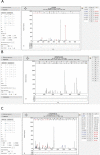The potential clinical impact of the release of two drafts of the human proteome
- PMID: 26496066
- PMCID: PMC4732427
- DOI: 10.1586/14789450.2015.1103186
The potential clinical impact of the release of two drafts of the human proteome
Abstract
The authors have carried out an investigation of the two "draft maps of the human proteome" published in 2014 in Nature. The findings include an abundance of poor spectra, low-scoring peptide-spectrum matches and incorrectly identified proteins in both these studies, highlighting clear issues with the application of false discovery rates. This noise means that the claims made by the two papers - the identification of high numbers of protein coding genes, the detection of novel coding regions and the draft tissue maps themselves - should be treated with considerable caution. The authors recommend that clinicians and researchers do not use the unfiltered data from these studies. Despite this these studies will inspire further investigation into tissue-based proteomics. As long as this future work has proper quality controls, it could help produce a consensus map of the human proteome and improve our understanding of the processes that underlie health and disease.
Keywords: Clinical applications; false discovery rates; human proteome; protein coding genes; proteomics.
Figures






Comment on
-
A draft map of the human proteome.Nature. 2014 May 29;509(7502):575-81. doi: 10.1038/nature13302. Nature. 2014. PMID: 24870542 Free PMC article.
References
•• One of the two papers studied in depth for this article. A proteomics analysis carried out wholly on tissues and hematopoietic cells.
-
- Wilhelm M, Schlegl J, Hahne H. Mass-spectrometry-based draft of the human proteome. Nature. 2014;509:582–587. - PubMed
•• The other paper that is the subject of this article. The tissue and fluid proteomics experiments were only a small part of this study.
-
- Venter JC, Adams MD, Myers EW. The sequence of the human genome. Science. 2001;291 - PubMed
-
- International Human Genome Sequencing Consortium Initial sequencing and analysis of the human genome. Nature. 2001;409
-
- Koenig T, Menze BH, Kirchner M. Robust prediction of the MASCOT score for an improved quality assessment in mass spectrometric proteomics. J Proteome Res. 2008;7:3708–3717. - PubMed
-
- Cox J, Neuhauser N, Michalski A. Andromeda: a peptide search engine integrated into the MaxQuant environment. J Proteome Res. 2011;10:1794–1805. - PubMed
•• A paper that is a counterpoint to the twoNature articles. The authors found that proteomics analyses detect peptides from the most ancient genes and very few from recently evolved genes. Proteins the two Nature studies claimed to have detected will have been removed from the reference genome as a result of this article
•• Another contrast to the two Nature papers. The PeptideAtlas update very elegantly finds that the two studies add no more than 500 proteins to those already identified in experiments on cell lines.
-
- Elias JE, Gygi SP. Target-decoy search strategy for increased confidence in large-scale protein identifications by mass spectrometry. Nat Methods. 2007;4:207–214. - PubMed
• One of the first papers to propose the calculation of false positive rates using decoy peptides.
• A detailed review of the use of false discovery rates in proteomics experiments, showing how errors are amplified when going from peptide to protein level.
• This paper sets out the potential harmful effects of combining large-scale high-throughput proteomics and insufficiently validated data.
-
- Cooper B. The problem with peptide presumption and the downfall of target-decoy false discovery rates. Anal Chem. 2012;84:9663–9667. - PubMed
• Explains how recent advances in high-throughput proteomics can easily lead to identifying peptides that do not exist.
-
- Bonzon-Kulichenko E, Garcia-Marques F, Trevisan-Herraz M. Revisiting peptide identification by high-accuracy mass spectrometry: problems associated with the use of narrow mass precursor windows. J Proteome Res. 2015;14:700–710. - PubMed
• The authors set out solutions for the problems identified in Ref. [33]
•• Details many of the shortcomings of the two Nature analyses and addresses the state of the art in protein detection.
• The paper discusses the concepts and potential pitfalls of proteogenomics studies in considerable detail.
-
- Ross PL, Huang YN, Marchese JN. Multiplexed protein quantitation in Saccharomyces cerevisiae using amine-reactive isobaric tagging reagents. Mol Cell Proteomics. 2004;3:1154–1169. - PubMed
-
- Huang Da W, Sherman BT, Lempicki RA. Systematic and integrative analysis of large gene lists using DAVID bioinformatics resources. Nat Protoc. 2009;4:44–57. - PubMed
• This large-scale study concentrates on cancer cells instead of tissues. Combining large-scale proteomics analysis of healthy and diseased cells has promise for the detection of biomarkers.
-
- Narayanan R. Phenome-genome association studies of pancreatic cancer: new targets for therapy and diagnosis. Cancer Genom Proteom. 2015;12:9–19. - PubMed
-
- Narayanan R. Ebola-associated genes in the human genome: implications for novel targets. MOJ Proteom Bioinform. 2015;1:00032.
-
- Shao S, Guo T, Aebersold R. Mass spectrometry-based proteomic quest for diabetes biomarkers. Biochim Biophys Acta. 2015;1854:519–527. - PubMed
• In this work, the authors review the current status of diabetes mellitus biomarker discovery through different mass spectrometry techniques.
-
- Hathout Y. Proteomic methods for biomarker discovery and validation. Are we there yet? Expert Rev Proteom. 2015;12:329–331. - PubMed
• A review detailing recent advances in the discovery of protein biomarkers via proteomics and the difficulties of validating these biomarkers.
-
- Aebersold R, Bader GD, Edwards AM. The biology/disease-driven human proteome project (B/D-HPP): enabling protein research for the life sciences community. J Proteome Res. 2013;12:23–27. - PubMed
• The authors find that lincRNA behave differently from protein coding transcripts when passing through the ribosome
Publication types
MeSH terms
Substances
Grants and funding
LinkOut - more resources
Full Text Sources
Other Literature Sources
Research Materials
